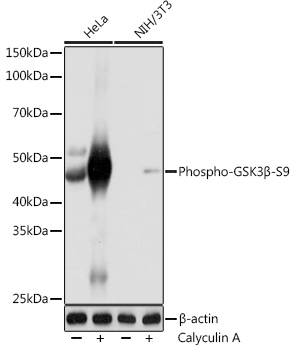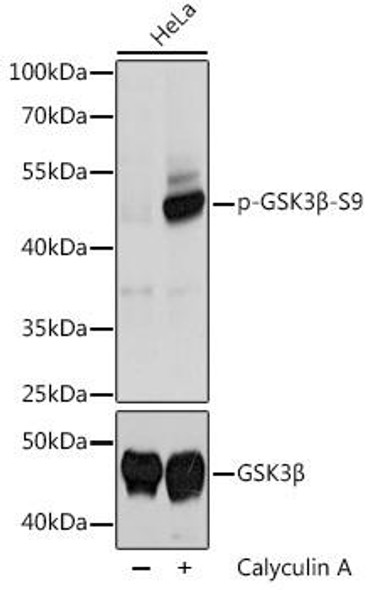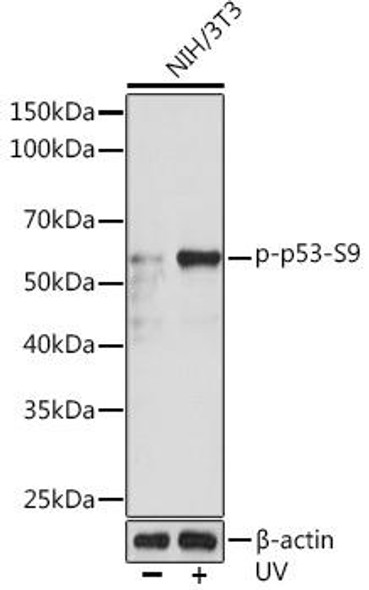Phospho-GSK3beta-S9 Monoclonal Antibody (CABP1088)
- SKU:
- CABP1088
- Product Type:
- Antibody
- Reactivity:
- Human
- Mouse
- Host Species:
- Rabbit
- Isotype:
- IgG
- Antibody Type:
- Monoclonal Antibody
- Research Area:
- Cell Biology
Description
Anti-Phospho-GSK3Beta-S9 Antibody (CABP1088)
The Phospho-GSK3beta (S9) Rabbit Monoclonal Antibody (CABP1088) is a valuable tool for researchers studying the phosphorylation status of GSK3beta, a key signaling molecule involved in various cellular processes. This antibody, generated in rabbits, specifically recognizes the phosphorylated form of GSK3beta at serine 9 and is validated for use in Western blot and immunohistochemistry assays.GSK3beta is a critical regulator of cell growth, proliferation, and survival, and its activity is tightly controlled by phosphorylation events. Phosphorylation of GSK3beta at serine 9 inhibits its activity, leading to downstream effects on cell signaling pathways.
This antibody enables researchers to study the phosphorylation status of GSK3beta in different experimental conditions, providing insights into its role in development, disease, and therapeutic interventions.With its high specificity and sensitivity, the Phospho-GSK3beta (S9) Rabbit Monoclonal Antibody is an essential tool for research in cell biology, signal transduction, and molecular biology. It offers a reliable means to investigate the regulation of GSK3beta phosphorylation and its impact on cellular functions, ultimately contributing to a better understanding of complex biological processes and disease mechanisms.
| Antibody Name: | Anti-Phospho-GSK3Beta-S9 Antibody |
| Antibody SKU: | CABP1088 |
| Antibody Size: | 20uL, 50uL, 100uL |
| Application: | WB IHC |
| Reactivity: | Human, Mouse |
| Host Species: | Rabbit |
| Immunogen: | A synthesized peptide derived from human Phospho-GSK3 beta (Ser9). |
| Application: | WB IHC |
| Recommended Dilution: | WB 1:500 - 1:2000 IHC 1:50 - 1:200 |
| Reactivity: | Human, Mouse |
| Positive Samples: | HeLa, NIH/3T3 |
| Immunogen: | A synthesized peptide derived from human Phospho-GSK3 beta (Ser9). |
| Purification Method: | Affinity purification |
| Storage Buffer: | Store at -20°C. Avoid freeze / thaw cycles. Buffer: PBS with 0.02% sodium azide, 0.05% BSA, 50% glycerol, pH7.3. |
| Isotype: | IgG |
| Sequence: | Email for sequence |
| Gene ID: | 2932 |
| Uniprot: | P49841 |
| Cellular Location: | Cell membrane, Cytoplasm, Nucleus |
| Calculated MW: | 46kDa |
| Observed MW: | 46KDa |
| Synonyms: | GSK3B, gsk-3Beta |
| Background: | The protein encoded by this gene is a serine-threonine kinase, belonging to the glycogen synthase kinase subfamily. It is involved in energy metabolism, neuronal cell development, and body pattern formation. Polymorphisms in this gene have been implicated in modifying risk of Parkinson disease, and studies in mice show that overexpression of this gene may be relevant to the pathogenesis of Alzheimer disease. Alternatively spliced transcript variants encoding different isoforms have been found for this gene.[provided by RefSeq, Sep 2009] |
| UniProt Protein Function: | GSK3B: a proline-directed protein kinase of the GSK family. Phosphorylates and inactivates glycogen synthase. Participates in the Wnt signaling pathway. Involved in energy metabolism, neuronal cell development, and body pattern formation |
| UniProt Protein Details: | Protein type:Protein kinase, CMGC; EC 2.7.11.26; EC 2.7.11.1; Protein kinase, Ser/Thr (non-receptor); Kinase, protein; CMGC group; GSK family; GSK subfamily Chromosomal Location of Human Ortholog: 3q13.3 Cellular Component: axon; beta-catenin destruction complex; cell soma; centrosome; cytoplasm; cytosol; dendritic shaft; dendritic spine; growth cone; lipid raft; mitochondrion; nucleus; perinuclear region of cytoplasm; plasma membrane; ribonucleoprotein complex Molecular Function:ATP binding; beta-catenin binding; integrin binding; ionotropic glutamate receptor binding; kinase activity; NF-kappaB binding; p53 binding; protein binding; protein kinase activity; protein kinase binding; protein serine/threonine kinase activity; tau protein binding; tau-protein kinase activity; ubiquitin protein ligase binding Biological Process: aging; axonogenesis; cell migration; circadian rhythm; dopamine receptor signaling pathway; epithelial to mesenchymal transition; ER overload response; establishment of cell polarity; fat cell differentiation; genetic imprinting; glycogen metabolic process; hippocampus development; myoblast fusion; negative regulation of apoptosis; negative regulation of dendrite morphogenesis; negative regulation of glycogen biosynthetic process; negative regulation of MAP kinase activity; negative regulation of neuron maturation; negative regulation of NFAT protein import into nucleus; negative regulation of nitric-oxide synthase activity; negative regulation of protein binding; negative regulation of protein complex assembly; organ morphogenesis; peptidyl-serine phosphorylation; peptidyl-threonine phosphorylation; positive regulation of axon extension; positive regulation of cell-matrix adhesion; positive regulation of GTPase activity; positive regulation of neuron apoptosis; positive regulation of peptidyl-serine phosphorylation; positive regulation of proteasomal ubiquitin-dependent protein catabolic process; positive regulation of protein binding; positive regulation of protein catabolic process; positive regulation of protein complex assembly; positive regulation of protein export from nucleus; positive regulation of smooth muscle cell proliferation; positive regulation of transcription from RNA polymerase II promoter; proteasomal ubiquitin-dependent protein catabolic process; protein amino acid autophosphorylation; protein amino acid phosphorylation; protein export from nucleus; re-entry into mitotic cell cycle; regulation of microtubule-based process; regulation of neuronal synaptic plasticity; response to activity; response to drug; response to estradiol stimulus; response to insulin stimulus; Wnt receptor signaling pathway; Wnt receptor signaling pathway through beta-catenin |
| NCBI Summary: | The protein encoded by this gene is a serine-threonine kinase, belonging to the glycogen synthase kinase subfamily. It is involved in energy metabolism, neuronal cell development, and body pattern formation. Polymorphisms in this gene have been implicated in modifying risk of Parkinson disease, and studies in mice show that overexpression of this gene may be relevant to the pathogenesis of Alzheimer disease. Alternatively spliced transcript variants encoding different isoforms have been found for this gene.[provided by RefSeq, Sep 2009] |
| UniProt Code: | P49841 |
| NCBI GenInfo Identifier: | 20455502 |
| NCBI Gene ID: | 2932 |
| NCBI Accession: | P49841.2 |
| UniProt Secondary Accession: | P49841,Q9BWH3, Q9UL47, D3DN89, |
| UniProt Related Accession: | P49841 |
| Molecular Weight: | 48,034 Da |
| NCBI Full Name: | Glycogen synthase kinase-3 beta |
| NCBI Synonym Full Names: | glycogen synthase kinase 3 beta |
| NCBI Official Symbol: | GSK3B |
| NCBI Protein Information: | glycogen synthase kinase-3 beta |
| UniProt Protein Name: | Glycogen synthase kinase-3 beta |
| UniProt Synonym Protein Names: | Serine/threonine-protein kinase GSK3B (EC:2.7.11.1) |
| Protein Family: | Glycogen synthase kinase |
| UniProt Gene Name: | GSK3B |
| UniProt Entry Name: | GSK3B_HUMAN |








